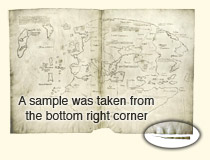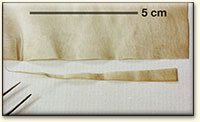|
|


Detailed view of the 8 cm long sample cut from the bottom right corner. The total area of the sample was about 2 cm2, roughly the size of a postage stamp.

|
Yes. The parchment is old.
In the mid 1990s, a sample piece was cut from the bottom of the map for Carbon-14 dating, and after nearly a decade of silence, the results were published in 2002. Two measurements dated it as contemporary and the rest dated it to 1425 (consistent with the age determined from the watermarks and writing on the map).
The two anomalous measurements do not actually date the manuscript as contemporary. They contain too much 14C (perhaps because of contamination from nuclear particles in the atmosphere).
Ignoring that, we can say that the carbon dating dates the parchment to a date consistent with Map being medieval, pre-dating the voyages of Christopher Columbus. What does this tell us? Either:
- The map is genuine, contemporaneous with the parchment, or
- The map is a later forgery drawn on old parchment.
Had the parchment been found to be modern, the Map would have been proven to be fake. But the parchment is medieval, as was expected. The Map was found bound in a 15th century book, and wormholes on the Map match wormholes on adjacent pages. Moreover, the watermark on the Map matches that those on adjacent pages in the book and the watermarks can by clearly dated to 1430.
Unfortunately, we can not date the ink using current technology. The amount of ink on the Map is too minute — it would take the whole Map to measure the age of the ink.
The parchment is old. Does that mean the map is old too? Or might a forger have drawn on a blank page from the book, or some other 15th century parchment?
< Previous Next > |